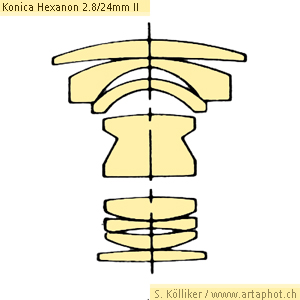Das Konica AR 2.8/24mm exisiert in zwei komplett unterschiedlichen optischen Varianten. Die Konstruktion der ersten Variante lehnt sich weitgehend an Vorbilder wie das Nikkor 2.8/24mm oder das Minolta MC Rokkor 2.8/24mm an, allerdings ohne deren mechanisch aufwändige Fassungskonstruktion mit floating elements zu übernehmen. Die zweite Variante - deutlich kleiner und leichter - hat eine prinzipiell ähnliche Konstruktion wie das Konica AR 2.8/21mm, mit dem zusammen es auch patentiert wurde.
Vergleicht man beide Versionen direkt nebeneinander, so zeigt sich schnell, dass die neuere Version eine überlegene Leistung bietet. Die ältere erste Rechnung hat bei Offenblende unscharfe Bildecken, und grossen Teile des Bildfeldes mangelt es an knackiger Detailschärfe. Dies sieht ab f5.6 deutlich besser aus, aber selbst bei f11 kommen die äussersten Ecken nicht wirklich gut aufgelöst (an 24 MP Vollformat). Wohl nicht ganz überraschend hat auch das frühe pre-Ai Nikkor 2.8/24mm ähnliche Schwächen.
Die neuere, kompakte "f22" Version hat ähnliche Probleme in den Bildecken, aber der Rest des Bildfeldes kommt bereits bei f2.8 recht kontrastreich und gut aufgelöst. Abblenden auf 5.6 steigert den Mikro-Kontrast noch etwas. Die Leistung dieser zweiten Version lässt sich durchaus mit den besten zeitgenössischen 2.8/24ern von Minolta (MD-III), Canon (new FD) ode Nikon (AiS) vergleichen.
There are two different computations of the Hexanon AR 2.8/24 mm. The early Hexanon AR 2.8/24 mm is rather large and heavy; its optical construction is similar to other early 2.8/24 mm lenses from Canon, Nikon and Minolta. The later "compact" computation − a positive leading construction which is quite a bit smaller and has some similarities with the Hexanon AR 2.8/21mm (same patent).
The lens barrel of the first "f16" version is quite rugged (metal), and all the engravings are well done. Focusing is a bit stiff, and the aperture ring is quite difficult to turn (a problem common to nearly all Hexanon AR lenses). Wide open, large parts of the image have a pretty low contrast. At f5.6 things look better, but even at f11 the corners are not really good yet. Later 2.8/24 mm lenses such as the Canon new FD 2.8/24mm or the Minolta MD-III 2.8/24 mm have less corner smearing and better resolution in the field (tested using 24 MP full frame cameras).
The second, compact "f22" version of the AR 2.8/24 mm is an outstanding performer over 90% of the full frame image; only the extreme corners suffer from reduced resolution. While the extreme corners are a bit worse, otherwise it clearly outperforms the early Nikkor (pre-Ai) 2.8/24mm. Its general performance is on-par with the best contemporary 2.8/24mm lenses from Canon (new FD 2.8/24mm), Minolta (MD-III 2.8/24mm) or Nikon (AiS 2.8/24mm).
 |
 |
KONICA HEXANON 24mm 1:2.8
|
 |
KONICA
HEXANON 24mm 1:2.8
|
|


